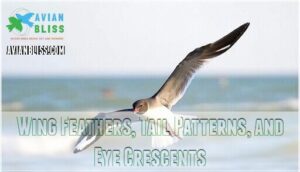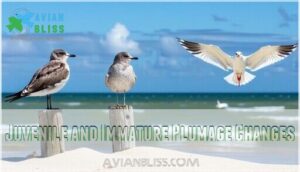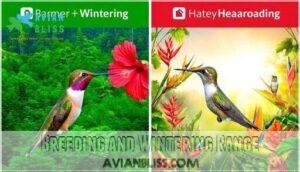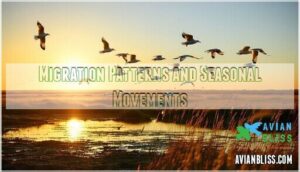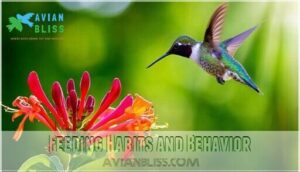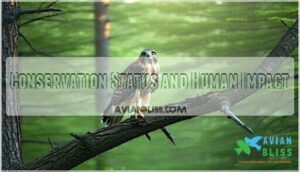This site is supported by our readers. We may earn a commission, at no cost to you, if you purchase through links.
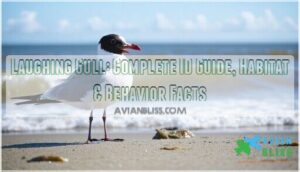
Laughing gulls inhabit Atlantic and Gulf coasts from Canada to South America, thriving in coastal marshes, beaches, and even urban areas like landfills. They’re opportunistic feeders who eat crustaceans, fish, and insects using various techniques from wading to aerial plunging.
These crafty birds are notorious food thieves who’ll boldly snatch catches from pelicans and other seabirds. Understanding their seasonal plumage changes and habitat preferences reveals fascinating insights about their exceptional adaptability.
Table Of Contents
- Key Takeaways
- Laughing Gull Identification Features
- Key Physical Traits and Life Stages
- Habitat, Range, and Migration
- Feeding Habits and Behavior
- Conservation Status and Human Impact
- Frequently Asked Questions (FAQs)
- Are Laughing Gulls rare?
- Why is it called a Laughing Gull?
- Are Laughing Gulls native to Florida?
- How do you identify a Laughing Gull?
- What type of bird is known for its loud cry?
- How do Laughing Gulls protect themselves from the sun?
- Can Laughing Gulls be pets or are they wild animals?
- How do Laughing Gulls communicate with each other besides calls?
- Are Laughing Gulls known to be aggressive towards humans?
- How long do laughing gulls typically live?
- Conclusion
Key Takeaways
- You’ll identify laughing gulls by their distinctive black heads during breeding season, bright red bills, and that unmistakable maniacal laugh that echoes across coastal waters – they’re medium-sized birds with gray wings and bold black wingtips.
- You can find these adaptable seabirds along Atlantic and Gulf coasts from Canada to South America, where they’ve learned to thrive in marshes, beaches, and even human-altered environments like landfills and parking lots.
- You’ll watch them use clever feeding strategies, including stealing food directly from pelicans by landing on their heads, plus they’re opportunistic feeders who eat crustaceans, fish, and insects using various hunting techniques.
- You’re witnessing a conservation success story – these birds recovered from near-extinction due to feather hunting in the early 1900s, though they still face threats from coastal development and climate change affecting their nesting colonies.
Laughing Gull Identification Features
You’ll recognize Laughing Gulls by their medium size and distinctive features that change with age. Look for their long wings, stout bills, and the black head stripe that develops in breeding adults.
Physical Characteristics and Size
When you spot a Laughing Gull, you’ll notice its medium build spans 15-18 inches in length. These gulls pack 7-13 ounces into their slender bodies. Their impressive wingspan stretches 36-47 inches across.
You can gauge their relative size against Ring-billed Gulls – they’re slightly smaller. Notice their stout bill length and long legs that give them graceful proportions for coastal living.
Color Pattern and Plumage by Age
Throughout their lives, laughing gulls undergo dramatic color pattern transformations that’ll help you age these coastal birds.
Adult laughing gull breeding plumage features striking black heads and bright red bills during summer months. Juvenile plumage shows brownish streaking and darker wing feathers.
Watch laughing gulls transform from brownish juveniles to striking black-headed adults through dramatic seasonal molts
The molting process creates seasonal changes as birds shift between breeding and non-breeding looks. Regional variations exist but remain subtle across their range.
Distinguishing Laughing Gulls From Similar Species
Looking for clear ways to tell Laughing Gulls apart from their close relatives? Gull Identification Challenges become manageable when you focus on key differences. Here are five reliable features for separating Laughing Gull from similar species:
- Bill shape: Laughing Gulls sport a longer, droopy bill versus Franklin’s Gull’s shorter, straighter version
- Wingtip markings: Less white at wingtips compared to Franklin’s Gull and Bonaparte’s Gull
- Eye crescents: Thinner, broken white arcs unlike Franklin’s Gull’s thick continuous crescents
- Size difference: Larger than Franklin’s Gull and Bonaparte’s Gull but smaller than Ring-billed Gull
- Behavior Differences: More aggressive food-stealing habits than most similar gulls
Regional Variations and Aging Plumage add complexity, but these core features remain consistent. They’re also known for their distinctive laughing calls. Hybridization Concerns are rare between these species.
Key Physical Traits and Life Stages
You’ll need to recognize Laughing Gulls through their changing appearance as they mature from young birds to adults. Their black heads, red bills, and distinctive wing patterns shift dramatically through three distinct life stages before reaching full adult plumage.
Distinctive Black Head and Red Bill
Adult laughing gulls sport distinctive black heads during breeding plumage from April through August. You’ll notice their bills transform from dull gray-brown to bright orange-red with seasonal changes. Head molting begins in late summer when black feathers gradually fade. Individual variation exists in bill coloration intensity. Features and behaviors make identification straightforward during peak breeding season.
| Season | Head Color | Bill Color |
|---|---|---|
| Spring Breeding | Solid Black | Bright Orange-Red |
| Summer Peak | Deep Black | Vivid Red-Orange |
| Late Summer | Mottled Black/White | Fading Orange |
| Fall/Winter | White with Gray | Dull Gray-Brown |
| Early Spring | Patchy Black | Brightening Orange |
Wing Feathers, Tail Patterns, and Eye Crescents
You’ll notice the Laughing Gull’s wing feathers are long and dark gray with distinctive black tips. The tail morphology changes dramatically through plumage stages – first-year birds show a complete black line across the tip, while second-year birds display a partial black line. Adult tails become completely white and squared.
White eye crescents become more prominent during molting patterns, helping distinguish this species from similar gulls.
Juvenile and Immature Plumage Changes
Young Laughing Gulls undergo dramatic changes through their first three years. First-year plumage shows brownish wing feathers and complete black tail bands. Second-year birds develop gray mantles and partial tail bands during molting sequence. By their third year, they sport white eyecrescents and completely white tails.
Age determination becomes easier as tail appearance transforms from banded to clean white through successive molt cycles.
Habitat, Range, and Migration
You’ll find Laughing Gulls along the Atlantic and Gulf coasts from Canada to South America, where they prefer coastal marshes, beaches, and artificial spoil islands for nesting.
These adaptable birds have learned to thrive around human activity, making landfills and dumpsters regular stops during their seasonal movements between breeding and wintering grounds.
Coastal Areas, Marshes, and Spoil Islands
You’ll find Laughing Gulls thriving in coastal nesting areas along Atlantic and Gulf coasts. These adaptable coastal bird species make their homes in marsh habitats and saltmarsh islands where salinity tolerance gives them an edge. Spoil islands created from dredging operations have become prime real estate for colonies.
Their habitat adaptations allow them to flourish in coastal lagoons and various coastal habitats where brackish water meets land. Identifying these birds is easier with coastal bird products.
Adaptation to Human-Altered Environments
Laughing Gulls thrive in Human-Altered Environments, turning our mistakes into opportunities. These adaptable birds have mastered Urban Gull Diets and Landfill Foraging while expanding their Range through Coastal Development Impact areas.
- You’ll spot them diving for scraps at busy garbage dumps
- They’ve turned parking lots into personal feeding grounds
- Spoil Island Nesting sites become bustling gull neighborhoods
- Their Human Waste Dependence shows nature’s clever resilience
Breeding and Wintering Range
East Coast Laughing Gulls establish their breeding grounds from Maine to Florida along Atlantic and Gulf coasts. These colonial nesters create impressive colony size gatherings, sometimes thousands strong.
While northern populations head south for winter distribution in Central America, southern birds stay put year-round. Recent range expansion shows breeding success improving in restored nesting habitats.
Migration Patterns and Seasonal Movements
Beyond their established wintering territories, Laughing Gull migration patterns reveal fascinating adaptability. After postbreeding wandering, these birds migrate south down the Atlantic and Gulf coasts, tracking climate impacts and responding to migration triggers that drive their seasonal movements. Understanding bird navigation methods is key to unlocking the secrets of their journeys.
- Migration Triggers: Temperature drops and food availability shifts initiate fall migration patterns
- Wintering Locations: Southern Texas, Florida, Caribbean islands, and Central America provide refuge
- Stopover Ecology: Coastal marshes serve as essential refueling stations during lengthy journeys
- Range Expansion: Climate change pushes traditional migratory routes further north each decade
Feeding Habits and Behavior
You’ll watch these clever gulls use multiple foraging methods to catch crustaceans, fish, and insects both in water and on land.
They’re also skilled food thieves who steal catches from pelicans and other seabirds by landing directly on their heads.
Diet of Crustaceans, Fish, and Insects
Throughout coastal waters, you’ll observe Laughing Gulls displaying notable dietary adaptations as opportunistic feeders. Their seasonal diet shifts between crustaceans, small fish, and insects based on availability. These gulls excel at prey selection, targeting horseshoe crab eggs during spring spawning events.
Understanding their diet can be enhanced by exploring available dietary products. Food competition drives their diverse foraging strategies across marine environments.
| Primary Prey | Seasonal Timing |
|---|---|
| Horseshoe crab eggs | Late spring |
| Small fish | Summer months |
| Marine crustaceans | Year-round |
| Flying insects | Warmer seasons |
Foraging Techniques and Food Stealing
When hunting, you’ll spot laughing gulls using impressive kleptoparasitism behavior. They steal fish directly from brown pelicans by landing on their heads and snatching prey from bill pouches.
Their foraging efficiency includes walking, wading, swimming, and aerial plunging. These feeding habits showcase notable diet adaptations as they target crustaceans and fish through opportunistic prey variety strategies.
Understanding their behavior requires observing daily feeding peaks.
Feeding in Mixed-Species Groups
You’ll spot Laughing Gulls feeding alongside diverse coastal birds through resource partitioning and group foraging strategies. Their kleptoparasitism behavior creates fascinating social hierarchies where they steal from pelicans and terns.
Watch for these mixed-species feeding scenarios:
- Snatching fish from Brown Pelican pouches
- Following shrimp boats with other seabirds
- Competing for crustaceans on mudflats
This interspecific competition shapes their feeding habits and diet choices.
Unique Vocalizations and Displays
You’ll regularly hear laughing gulls’ distinctive vocalization repertoire echoing across coastal areas. Their famous laughing call acts as the primary social communication tool during courtship and territorial disputes.
Males perform head-toss mating displays while delivering loud calls to attract females.
Listen for short stuttered alarm calls when threats approach nesting areas, plus unique chick vocalizations from young birds. The characteristic facing-away displays complement their vocal performances.
Conservation Status and Human Impact
You’ll discover that Laughing Gulls overcame near-extinction from feather hunting in the early 1900s and now thrive across many coastal areas.
However, you should know that beach development and climate change still threaten their nesting colonies, making responsible coastal recreation essential for their continued success.
Population Recovery and Past Threats
Why did Laughing Gulls nearly disappear? You’d be shocked at what almost wiped them out. These coastal birds faced serious threats that decimated their numbers:
- Feather Trade hunting for hat decorations
- Egg Collection from breeding colonies
- Habitat destruction along coastlines
- Unregulated hunting practices
- Lack of Legal Protections
Conservation Efforts and species management saved them. Current Numbers show steady recovery thanks to stronger coastal habitat protections.
Habitat Loss and Climate Change Risks
Coastal habitats face a perfect storm of threats. Rising sea levels and storm surges wash away nesting sites, while coastal development fragments the remaining areas.
Since 1993, laughing gull colonies south of Wallops Island have declined by over 90 percent due to tidal flooding. Audubon’s climate model predicts a 58 percent loss of the current summer range by 2080.
Conservation strategies must address habitat degradation by reducing human impact and implementing efforts to protect vulnerable coastal marshes.
Colonial Nesting and Lifespan
Thousands of nesting pairs create bustling colonies on beaches and marsh islands. Colony size ranges from dozens to several thousand breeding pairs.
Nesting behavior involves ground scrapes lined with grass and debris. Both parents incubate eggs for twenty days. Chick development takes about five weeks before fledging.
Lifespan factors include predation and weather conditions. Breeding success depends on undisturbed colony sites and adequate food sources nearby.
Human Activities Affecting Breeding Colonies
Despite their adaptability, human impact threatens breeding colonies through various disturbances. Coastal development destroys nesting sites, while beachgoers and off-leash pets disrupt colonies. Conservation efforts focus on protecting these vulnerable areas from habitat destruction and pollution impacts.
Key threats to breeding success:
- Colony disturbance from foot traffic and vehicles on beaches
- Coastal development replacing marshes with buildings and infrastructure
- Mammalian predators like cats and dogs accessing nesting areas
- Pollution impacts from landfills and chemical contamination
- Tidal flooding worsened by climate change and development
Frequently Asked Questions (FAQs)
Are Laughing Gulls rare?
Population studies show these birds aren’t rare at all. You’ll find their numbers increasing in many coastal areas thanks to their adaptability to human environments.
They’ve bounced back strong since protective laws ended feather hunting.
Why is it called a Laughing Gull?
You’ll hear this bird’s distinctive call echoing across beaches. Its "ha-ha-ha" vocalization sounds remarkably like human laughter, earning this coastal gull its perfectly descriptive name.
Are Laughing Gulls native to Florida?
Yes, you’ll find Laughing Gulls are native to Florida’s coasts. They naturally breed and live along the Atlantic and Gulf coastlines, making Florida’s shores their traditional home territory.
How do you identify a Laughing Gull?
Look for a medium-sized gull with long wings and legs. You’ll spot their stout bill, dark gray wings with black tips, and white body.
Check the tail pattern – it changes with age from black-tipped to completely white.
What type of bird is known for its loud cry?
Several bird species produce remarkably loud calls. The White Bellbird produces the loudest avian sounds on Earth.
Common Ravens make gurgling croaks and harsh grating sounds. American Barn Owls make harsh screams lasting about two seconds.
How do Laughing Gulls protect themselves from the sun?
You’ll spot these coastal birds facing the sun on hot days to minimize heat absorption.
They rotate their bodies to present their narrowest profile, keeping their heads and necks aligned with the sun’s rays.
Can Laughing Gulls be pets or are they wild animals?
Laughing Gulls are wild animals protected by federal law. You can’t legally keep them as pets.
They need specialized diets, large territories, and social interaction with other gulls to thrive properly.
How do Laughing Gulls communicate with each other besides calls?
Beyond calls, you’ll notice these birds use body language to chat. They peck at each other’s neck feathers during mating. Males spread their wings while courting females.
Head positioning signals dominance and aggression between rivals.
Are Laughing Gulls known to be aggressive towards humans?
Don’t worry—these coastal characters aren’t out to cause you harm. You’ll find these opportunistic birds more interested in your sandwich than starting trouble, though they can get pushy when begging for handouts at beaches and parking lots.
How long do laughing gulls typically live?
You’ll find these coastal birds stick around for about 10-20 years in the wild.
Maximum longevity from banding studies reaches 22 years, though most don’t make it quite that long due to natural challenges.
Conclusion
Studies show laughing gulls can live over 20 years in the wild despite facing numerous environmental challenges. You’ve now learned to identify these adaptable seabirds by their seasonal black heads, distinctive calls, and opportunistic feeding behaviors.
Whether you’re spotting them stealing food from pelicans or watching them thrive in urban landfills, laughing gulls demonstrate notable resilience across their coastal range. Their recovery from near-extinction proves these clever birds will likely continue entertaining beachgoers for generations.


